
There’s a quote in Jordan that says: “Even when you’re full, you can still always eat 40 more bites of food.” ©
This purely reflect on the generosity and hospitality of Jordanian people, and the importance of giving such delicious food with passion in Jordan.
Jordanian food is diverse and varied like its history, culture, and landscapes. Due to Jordan’s central geographical location, you’ll enjoy the food with charming mix of cultures and civilizations.
When you are dining in Jordan you can have spiced rice, fresh bread, and hunks of fall apart tender lamb, besides appetizingly refreshing dishes such as Arabic salad, Fattoush, Yalanji, raw vegetables, and many creamy plates like Labaneh and Hummus.
Food is an integral part of Jordanian culture, so when you are having a meal in a Jordanian restaurant, you will meet and mingle with the most welcoming and hospitable people you’ve ever met.
If you’re a food lover, here is a Jordanian food guide list. You have to try these when you’re visiting Jordan!
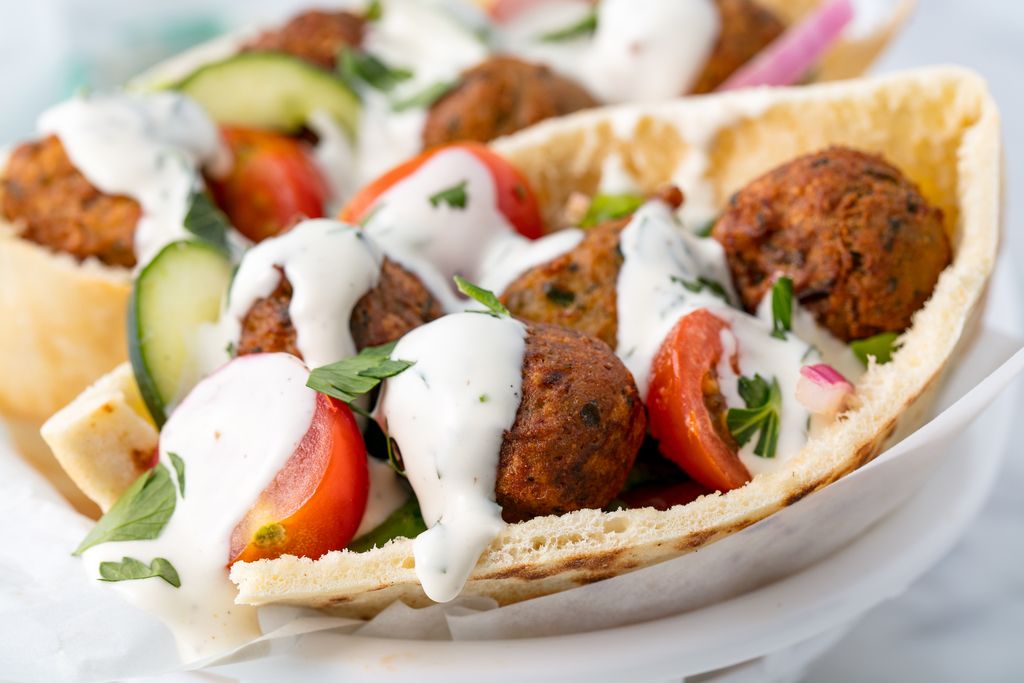
Those delightful little balls of fried chickpea flour and the best of Middle Eastern spice. It is one of the most common street food snacks or light meals in Jordan. Light and fluffy on the inside, crispy on the outside, with an aroma of cumin, garlic, and parsley, they can be eaten on their own like veggie nuggets, eaten with bread, or stuffed into sandwiches.

The word Moutabel, literally means ‘to add additional flavors and spices’. It is made of two main basic ingredients, eggplants and tahini. Some countries in the Middle East refer to this dish as Baba-Ghanouj. In Jordan, Baba Ghanouj is a different type of dish; it is also prepared with roasted eggplants but it is without sesame paste and includes tomatoes. Both are delicious!

That is a dish that works well on its own but is best served as a side or base for many other favorite eats. Hummus has been adopted into the Western cuisine, but we dare say that store-bought is not the same as the real homemade experience. The thick spread is made from chickpeas, sesame seeds, olive oil, lemon and garlic and is served with plentiful Jordanian bread. Not only does it taste fantastic but it’s actually very good for you.

Fattet hummus is the combination of bread, which has been soaked in broth to make it completely dissolvable, mixed with hummus, tahini, and lemon juice.
Fattet hummus is a complete twist on regular hummus. While it has that similar garbanzo bean taste, with a hint of lemon juice and olive oil, the texture is totally different – it kind of feels like whipped hummus. It’s fluffy and airy like whipped cream, not nearly as dense or thick as regular hummus.
The dish of lamb or chicken and rice is doused with ‘jameed’ dried yoghurt, which is mixed with hot water and made into a heavy but delicious sauce. Mansaf is what the Bedouin have been offering guests and travelers for hundreds, perhaps thousands, of years. Traditionally served on a huge platter and eaten communally, always with the right hand, it is a symbol of humanity and hospitality in an inhospitable environment. Tourists passing through the beautiful arid sandscapes of Wadi Rum can enjoy al fresco feasts with Bedouin hosts under the stars.
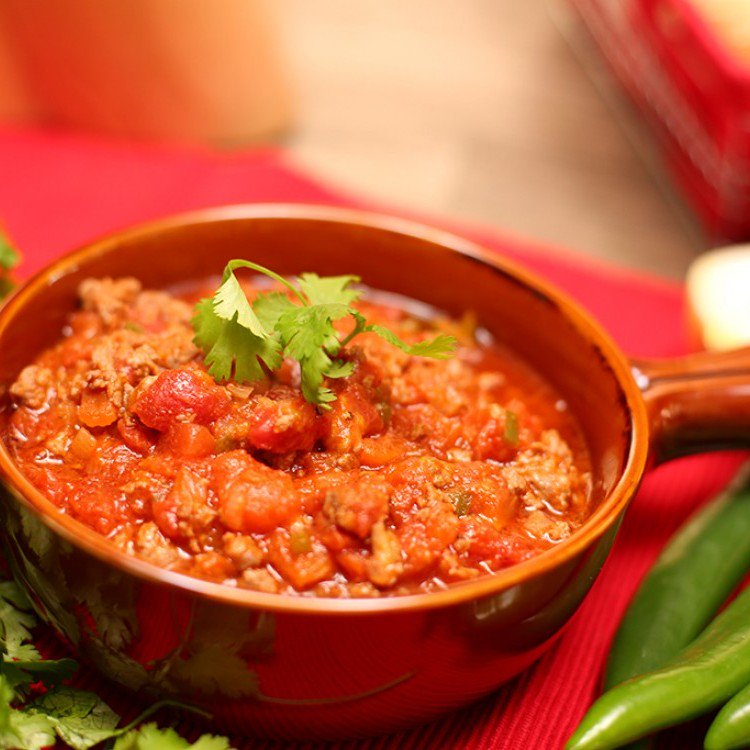
Galayet Bandora is basically sautéed tomatoes stewed with garlic, olive oil, pepper, and salt! It can be either cooked plain, just tomatoes, or it can be cooked with minced meat or with eggs. Either way, it is very delicious! Oh and super healthy.
You must have tried Galayet Bandora in a restaurant here. It is very common to see it on the menus in Arabic restaurants under “Sides/Starters”. Galayet Bandora is usually eaten with fresh (from the oven) pita bread and it can be sprinkled with pine nuts!

Warak Enab, or stuffed grape leaves, and Kousa Mahshi, which are stuffed zucchini, can sometimes be served together, and they are another fantastic addition to Jordanian cuisine. Versions of this dish are commonly eaten throughout the Middle East and Mediterranean.
Both the grape leaves and the zucchini are stuffed with a combination of rice and ground meat, onions, and light seasonings, then wrapped up, and slow cooked.
Another Levantine dish, often a starter or salad, tabbouleh is a mixture of finely minced parsley, tomatoes, garlic, and bulgur wheat, all dressed in lemon juice, salt, and olive oil. As I learned in Jordan, tabbouleh is not typically scooped up with bread like hummus or moutabel, but it’s typically eaten plain with a spoon.
Similar in dressing taste to tabbouleh, but with a different vegetable make-up, Jordanian, or Arabic salad, usually includes finely diced up cucumber, tomatoes, and bell peppers, dressed in lemon juice and lots of olive oil.
Arabic salad makes an excellent refreshing starter dish or with main dishes like maqluba (rice and meat) and with grilled dishes like shish kebabs – to give the meal a nice balance. Fattoush is another common salad you can eat in Jordan.
Crushed fava beans served with a variety of toppings such as olive oil, lemon juice, parsley, chili pepper, sumac and more. A hearty dish.
Commonly served as a mezze dish, along with dishes like hummus and moutabel, chicken livers is another fantastic Jordanian dish to complement your meal. The chicken livers are typically sautéed in olive oil with just a few simple seasonings like garlic, parsley, and salt, and then sprinkled with some lemon juice.
Liver is not everyone’s favorite part of the chicken, but I would say that you’ve got to give them a chance. A piece of bread, with a liver, and some hummus, is a wonderful combination bite.
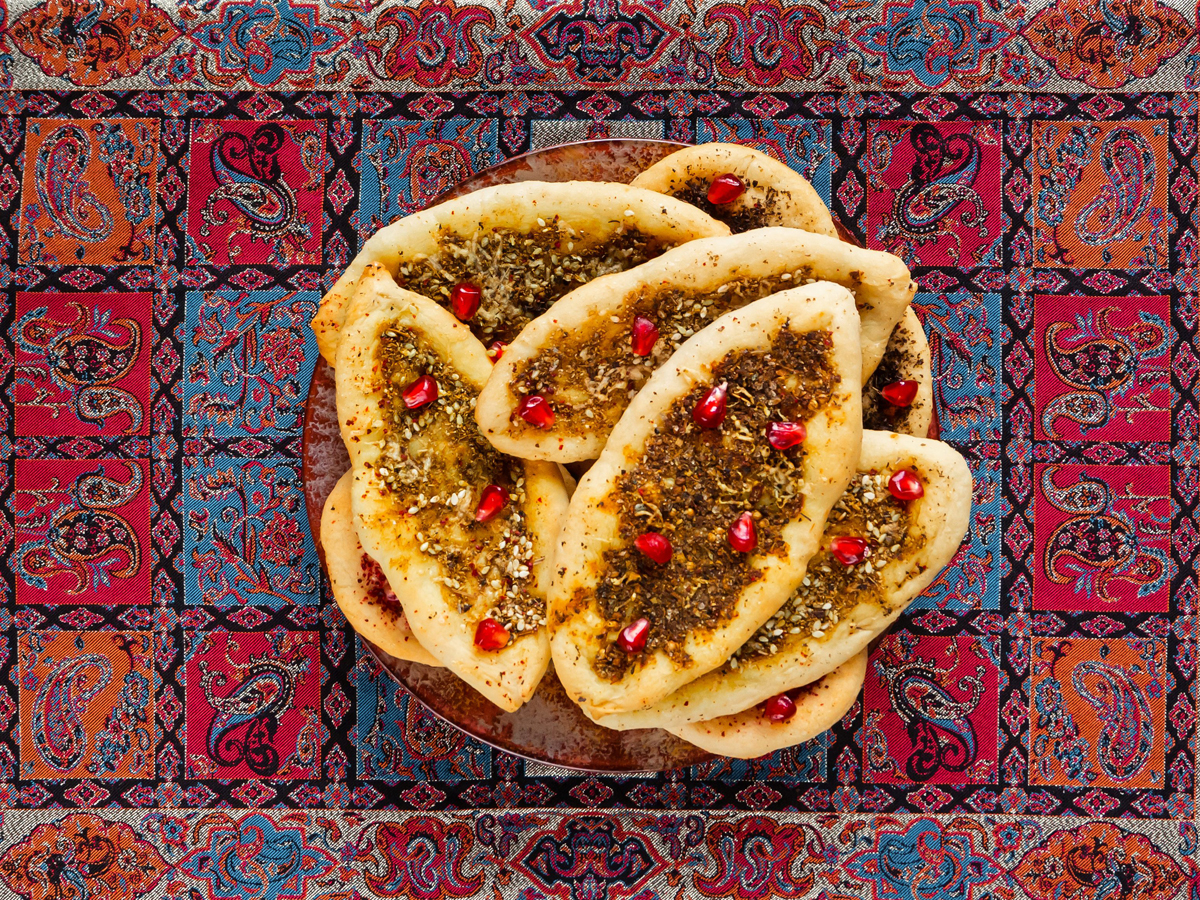
Sometimes called Arabic pizza, Manakish is essentially a round of dough, topped with za’atar (an herb thyme spice mixture), olive oil, and can then optionally include toppings like white cheese (halloumi), eggs, or ground meat. It’s then baked in a brick oven.
When Manakish is hot and fresh, right out of the oven, it’s incredibly delicious – the crusty bread with a fluffy inside, and that wonderful herb taste.
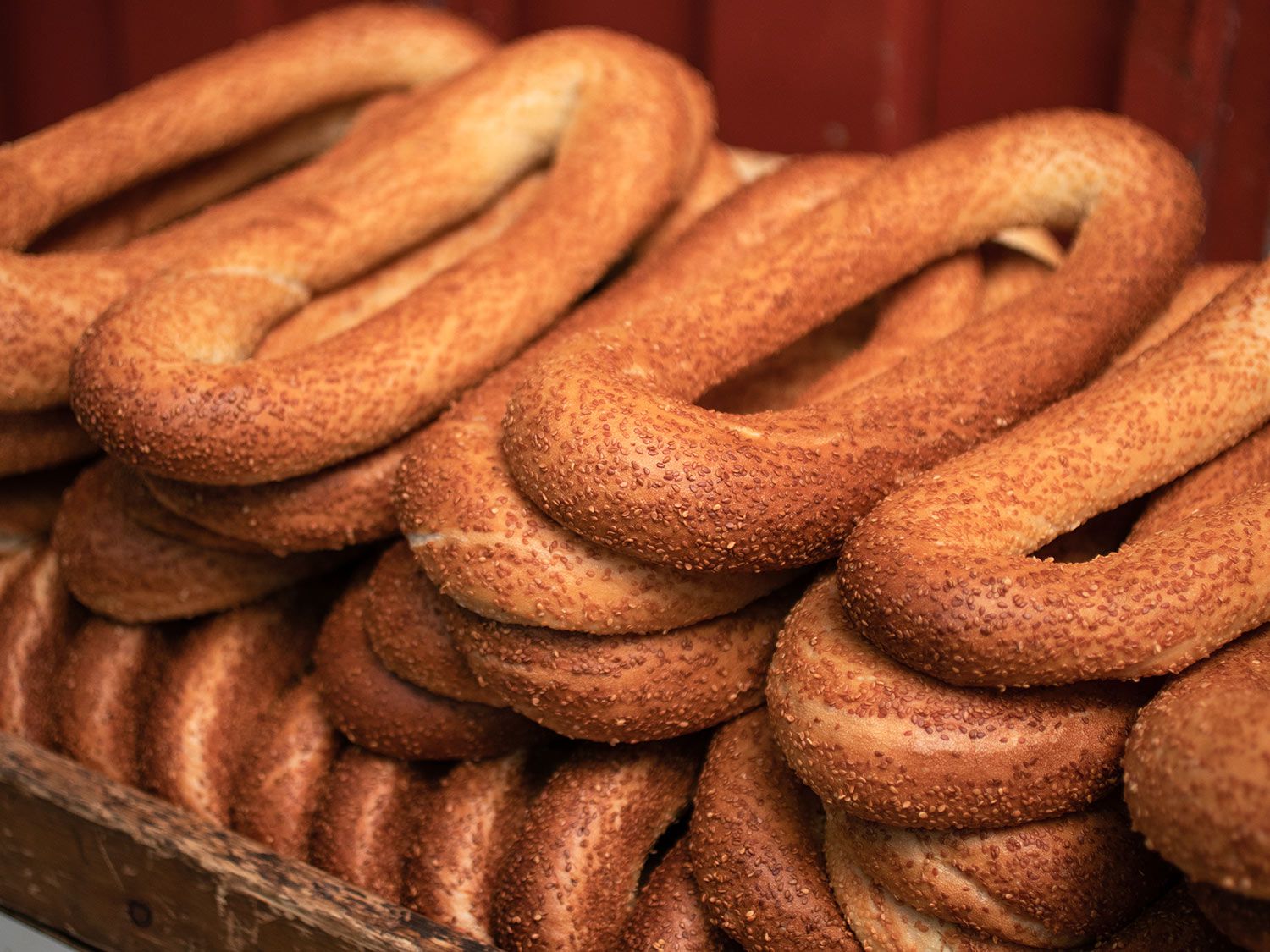
One of the most popular Jordanian street food snacks, especially common in the morning, is a Kaek bread sandwich. The bread, which is in the shape of a mini personal loaf, is topped in a crust of sesame seeds, and can be filled with Happy Cow like triangles of cheese, hard baked eggs, za’atar, and chili sauce. It’s simple, tasty, and very common.
Kaek sandwiches taste the best when they are piping hot – when the bread is cooked fresh. If you visit Amman, there’s a legendary bakery, known as Salaheddin Bakery (مخبز صلاح الدين), which is not only one of the oldest bakeries in Amman, but it serves one of the best sesame bread sandwiches in the city. Grab a fresh loaf, add all the toppings yourself, and take a bite of one of the most incredible loaves of Kaek in Jordan.
A typical everyday Jordanian food is mujadara, a mixture of rice, lentils, and a seasoning that includes cumin. It’s something that nearly everyone knows the recipe for how to cook it at home, and it’s commonly eaten as a dish that’s quick and easy. It’s also a favorite main dish for vegetarians in Jordan as well, as its filling and tastes delicious.
Additionally, deep fried caramelized onions and fried fragrant pine nuts sprinkled on top, are the two ingredients that take mujadara to the next level.
A meat lover’s favorite from Europe to the Middle East, shawarma is common in Jordan and you’ll find restaurants that serve lamb, beef, and chicken versions. The signature method of cooking shawarma – layers of thin meat stacked on a sword like spit and revolving either vertically or horizontally over a source of heat – is part of what gives the meat its unique taste. When the outer layer of meat is cooked, it’s shaved off with a sharp knife, and usually wrapped in bread with either garlic sauce or tahini and a few pickled vegetables.
If you didn’t know that Arayes was grilled, you might actually think it’s deep fried, because it’s so crispy. Arayes, which translates directly to the bride, is essentially two layers of pita bread, filled in the middle with minced lamb, onions, parsley, and with a fragrant allspice seasoning.
The quesadilla shaped Arayes is then brushed with olive oil and grilled over hot charcoal so that it turns golden brown and crispy on the outside. The combination of that roasted olive oil bread and the oil of the minced lamb seeping into the bread, makes it irresistible.
Popular across the Middle East and the Levantine, shish & kebab in Jordan are typically made from minced lamb or chicken breast, which is mixed with parsley and lots of salt, then molded onto big sword like skewers, and grilled over hot charcoal. The saltiness of the meat, and the ratio of meat to fat, ensures the maximum of grilled flavor gets packed into the kebabs.
Kind of similar to shish kebabs, just in a completely different form, Kofta bi tahini is a dish that includes a bottom base layer of minced kebab (or Kofta) meat, flattened out into a patty, topped with thin slices of potato, doused in a thick tahini sauce, and then baked.
The meat on the bottom is like a base of sausage, that wonderful parsley flavored minced meat. If I didn’t know the white thick sauce all over Kofta bi tahini was tahini, I might think it was some kind of milk based cream white gravy, because it was so rich and creamy. But instead it had a slightly nutty taste, and it wasn’t nearly as heavy as a dairy based sauce.

Musakhan is a Jordanian and Palestinian dish of slices of bread, chicken, heaps of onions, fragrant spices like allspice and cinnamon, and lots of olive oil. The ingredients are stewed together until the onion, chicken, olives, and bread are fall apart tender and the spices have blended and harmonized. While the spices have a sweet tinge to them, the actual dish is not sweet.

Kibbeh are little deep fried nuggets of minced meat, onions, and spices, wrapped in a crust of bulgur wheat, and deep fried until golden crispy on the outside. The dish is commonly eaten on its own, or as a mezze dish or snack, along with a variety of different dishes like hummus or moutabel.
But for kibbeh Labanieh, after the kibbeh are done being prepared, they are then cooked in a yoghurt sauce, which not only transforms their taste and texture, but also turns them more into a main dish as opposed to a snack.
Literally translated at upside down, maqluba includes meat or chicken on the bottom, rice, and spices, all cooked together in one pot. Once the dish is ready, the pot is flipped over onto a big plate or communal tray, so the rice stays on the bottom, and the meat or chicken is left on the top. Maqluba can be garnished with parsley, fried pine nuts or other types of nuts, and slices of lemon.
The rice, since it’s cooked with meat or chicken, takes on a lovely broth flavor kind of like chicken rice (if you eat chicken maqluba), and the meat or chicken becomes fall apart tender from the long cooking process.
Similar to a Polynesian underground meat roast, the Jordanian Bedouin version of an underground oven is known as Zarb. A mix of meat like lamb and chicken, rice, onions and carrots, are placed in a square hole in the ground, which is filled with flaming hot coals. The hole is then covered with a few layers of blankets to hold in the heat and finally sand is covered over the oven.
After a few hours, the meat and rice are all smoked, steamed, and grilled, all at the same time. The result is meat that’s fall apart tender. I had Zarb for dinner while visiting the incredible WadiRum desert. Just like a few other dishes, it was served on a giant communal tray, rice at the bottom, a shoulder of lamb and all the vegetables on top.
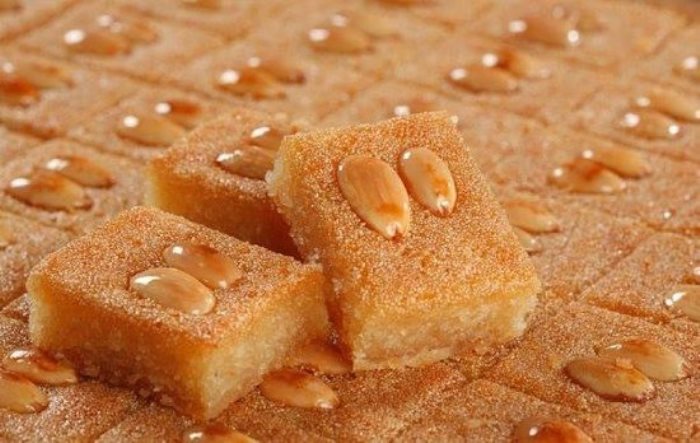
Hareeseh is a sweet made with semolina, coconut, cream, sugar, yoghurt, and almonds, all baked until golden brown. Hareeseh is prepared in bar form, kind of like the size and density of a brownie (although nothing like it in taste). It’s a very sweet dessert, and has a slight floral taste to go with the grainy texture of the semolina.
Cheese is the most noticeable of ingredients in Knafeh, which is paired with either noodles or semolina, drenched in a sticky rose scented syrup, and topped with a pinch of ground pistachios. The cheese on the bottom tastes similar to mozzarella, while the top crust is crunchy and gooey.

Baklava or Baklawa is a pastry made of multiple layers of paper-thin dough with ground nuts as a filling, baked and then drenched in the syrup of honey and sometimes rosewater. The crunchy and like velvet layers of baklava is the perfect mixture of your particular treat time. This yummy pastry is known worldwide and best served with Turkish coffee.
Also spelled as Om Ali is a dessert combining the creaminess of a bread pudding and cinnamon nut stuffing of baklava (baklawa). Umm Ali is made of milk, sugar, butter, cream, raisins, crushed hazelnuts, split almond, ground cinnamon & shredded dry coconut.
This Middle Eastern dessert is milk based, clotted with rice flour or a cornstarch and then topped with sweet syrup. Best served garnished with chopped walnuts or pistachios.
Also spelled as Maamoul are small pastries filled with dates, walnuts or pistachios. Maamoul is made on special occasions like Eid al Adha and Eid Al Fiter. This Arabic dessert is a soft cookie dough packed with dates that are perfumed with cardamom and cinnamon.
Finally, this is not part of the Jordanian food guide list, but this article can’t be ended without mentioning Turkish coffee and mint tea. You will definitely enjoy these two beverages, during your trip to Jordan, making your visit even more memorable.
Turkish coffee, which is served thick and muddy, is spiced with cardamom and you’ll find it at restaurants, street food stalls, and gas stations. There’s also Arabic coffee, but Turkish style coffee seems more common. Mint tea, which is often just black tea poured into a cup with a few fresh mint leaves in the bottom, is a typical after meal drink.
When you’re leaning back in your chair, massaging your stomach full of rice, lamb, and jameed, sipping on a cup of mint tea is hard to beat.